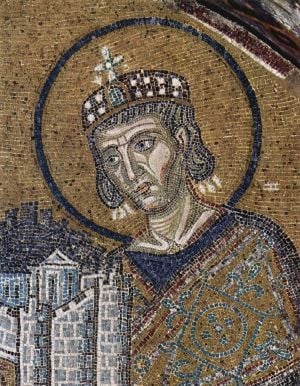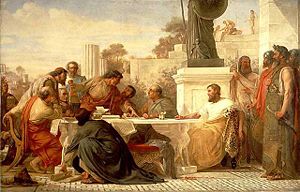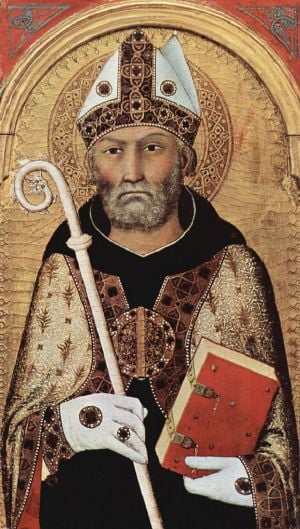Donatist
The Donatist movement was a branch of Christianity in north Africa which began in 311 C.E. and flourished for a century until the Council Carthage in 411. Named for
Background
The Donastist movement's roots can be found in the persecution of the Christian church under Emperor Diocletian. On February 24, 303 the Emperor banned the Christian religion and commanded both the destruction of the churches and the buring of Christian scriptures. In 304, he issued an edicting declaring the Christians must be willing to offer incense at the altars of the state or face death. The persecution lasted only a brief time in Africa but it was particularly severe there. Many martyrs met their death as a result, some willingly informing authorities that they possessed sacred scriptures but refused to give them up. Mensurius, the Bishop of Carthage, forbade such practices and admitted to handing over "heretical" scriptures to the authorities while hiding legitimate scriptures in his home. On the other handSecundus, the Bishop of Numidia praised the martyrs of his province who had been put to death for refusing to deliver up the scriptures. He declared himself "not a traditor"—a term refering to those who had cooperated with authorities by giving them either holy scriptures, sacred church vessels, or the names and persons of fellow Christians.
Some of the Christians of Carthage and other cities broke off relations with Mensurius, considering him, rightly or wrongly, a traditor. Minutes of state investations indeed show that some bishops cooperated with the state, being willing to hand over all that the state required, except, in some cases, their fellow Christians.
By 305 the persecution had abated and a church council, or synod, was held at the African city of Cirta. Bishop Secundus, however, launched an investigation to ensure that there were no traditores present. Shockingly, it was determined that most of the bishops present fell under one definition or another of the term. Later, when Mensurius died in 311, his archdeacon, Cæcilianus, succeeded him, but without consultation with the Secundus and the nother Numidian bishops. Numidian bishops felt much offended at the slight shown to them, and allied themselves with the rigorists. Secundus now convened another synod, and when Cæcilianus failed to appear to defend himself, he was deposed and excommunicated. The synod elected Majorinus in his place as Bishop of Catharge. When Majorinus himself soon died in 313, his successor would be Donatus. It is from this Donatus that the Donatist schism received its name.
Cathage, the captial city, now had two bishops and two competing congregations. The schism soon spread throughout the whole province, with a majority of the people, as well as a sizeable number of bishops, supporting Donatus. Outside of Africa, however, the bishops generally recognized Cæcilianus.
The Donatist churches
Theological issues
The Donatists' primary disagreement with the rest of the Church over the question of the legitimacy of sacraments dispensed by traditores. The Donatists refused to accept the sacraments and spiritual authority of the priests and bishops who had fallen away from the faith during the persecution. Under the Emperor Constantine, the issue became particularly intense, as many fallen-away priests returned to the Church to take advantage of the favored positions they would now having under Constantine's protection and support. The Donatists, however, proclaimed that any sacraments celebrated by these lapsed priests and bishops were invalid.
Two theological questions now confronted the Church as a result of the schism. The first was whether the sacrament of penance can effect a reconciliation whereby the apostate, specifically the traditor, may be returned to full communion. The Catholic position was "yes, although at the time the Church still followed a tradition in which the penitent for such a grievous offense might spend years of public contrition before being admitted to the Eucharist again. The Donatists, on the other hand, held that such a crime, after the forgiveness of baptism, rendered one unfit for further membership in the Church. Indeed, the term "Catholic (universal) Church" came into use during this time to express the universality of the Catholic position versus the more narrow definition of holiness expressed by the Donatists.
The second question was the validity of sacraments conferred by priests and bishops who had been apostates under the persecution. The Donatists held that such sacraments were invalid. By their sinful act, lapsed clerics had rendered themselves incapable of celebrating valid sacraments. The Catholic position was that the validity of the sacrament depends upon the holiness of God, not the minister being a mere instrument of God's work, so that any priest or bishop, even one in a state of mortal sin, is capable of adminstering a valid sacrament. The pertained not only the Eucharist, which was administered on a weekly or even a daily basis, but also to baptisms, ordinations, marriages, and last rites.
The schism widens
Many towns were divided between Donatist and non-Donatist congregations. Constantine, as emperor, soon involved himself in the dispute. His edict of 313 promised the Church of Africa his protection and favor, but not the Donatists. In 314 Constantine called a council at Arles in France. The issue was debated and the decision went against the Donatists. The Donatists, already suspicious of any cooperation between the Church and the Empire, refused to accept the decision of the council. After Donatus was officially deposed as bishop by a council headed by the Bishop of Rome, the Donatists uncharacteristically appealed directly to the Emperor. At Milan in 316, Consantine ruled that Cæcilianus, not Donatus was the rightful bishop of Catharge.
In 317 Constantine sent troops to force the Donatists in Carthage to submit. Thus, for the first time, the Christians of one faction used the military and police power of the state to persecute other Christians. Constantine's actions resulted in banishments and even executions. It also failed completely, as the Donatists grew all the more fierce in their convictions, and Constantine was forced to withdraw in 321.
Constantine's son, Constans, launched a new wave of persecutions against the Donatists. Elements of the Donatists coalesced with the more radical Circumcelliones in opposition. By the time Cæcilianus died in 345, all hope of peaceful reconciliation of the two Donatists and Catholics had past. Constans succeeded in repressing the movement somewhat, and Donatus himself was banished.
The accession of Julian the Apostate, however, relaxed the restrictions against the Donatists as Julian sought to encourage those who opposed the Catholics' power. Althogh Donatus had by this time died, Julian appointed Parmenianus, a Donatist as the official Bishop of Carthage.
For a time, between 372 and 375, the usurper Firmus ruled an independent government in North Africa and supported the Donatists, while repressing the Catholics. After his revolt was put down, however, more laws against the Donatists were issued by Emperor Valentinian I.
In addition to their theological and political differences with the Catholics, the Donatists also evolved a distinctive worship style, emphasizing what one commentor calls "mystical union of the righteous inspired by the Holy Spirit and instructed by the Bible."[1] In this they may have inherited some of the former zeal of an earlier heretical movement centered in Carthage, namely the Montanists. Indeed, the Donatists consciouly drew from the writings of the pietist Church Father Tertullian, who had been a Montanist in his later years, as well as his fellow Carthaginian and champion of holiness, SaintCyprian. Later, Anabaptists and other Protestant traditions have looked to Donatists as historical predecessors because of their opposition to the union of Church and state, their emphasis on discipleship and, in some cases, their opposition to the corruption of the Catholic hierarchy.
Fifth century developments
In the early fifth century Saint Augustine campaigned strongly against the Donatist belief throughout his tenure as Bishop of Hippo, and through his efforts the Catholic Church gained the upper hand. His view, which was also the majority view within the Church, was that it was the office of priest, not the personal character of the incumbent, that gave validity to the celebration of the sacraments. Augustine's writings also provided a justification for the state's use of violence to intervene on behalf of orthodoxy, a view which was put to much use by the medieval Church in its various campaigns against heresy.
In 409, Marcellinus of Carthage, Emperor Honorius's secretary of state, decreed the group heretical and demanded that they give up their churches. The Council of Carthage in 411 feature a large gather of both Catholic and Donatist bishops. Augustine himself was one of the main spokemen of the former. Eventually the imperial commissioner declared the Donatists to be banned, and severe measures were taken against them. After losing their civil rights in 414, they were forbidden to assemble for worship the next year, under penalty of death. The Donastists were so harshly persecuted by the Roman authorities that even Augustine, who had earlier justified the state's intervention, protested their treatment.
Honorius' successes in putting down the Donatists, however, were reversed when the Vandals conquered North Africa. Donatism survived both the Vandal occupation and the Byzantine reconquest under Justinian I. It persisted even into the Muslim period, during which it disappeared.
- ↑ Murray, Stuart, The Donatists — A fairly in-depth article on the origins of the Donatists, their fluctuating fortunes between 317 and 535, and their beliefs.



